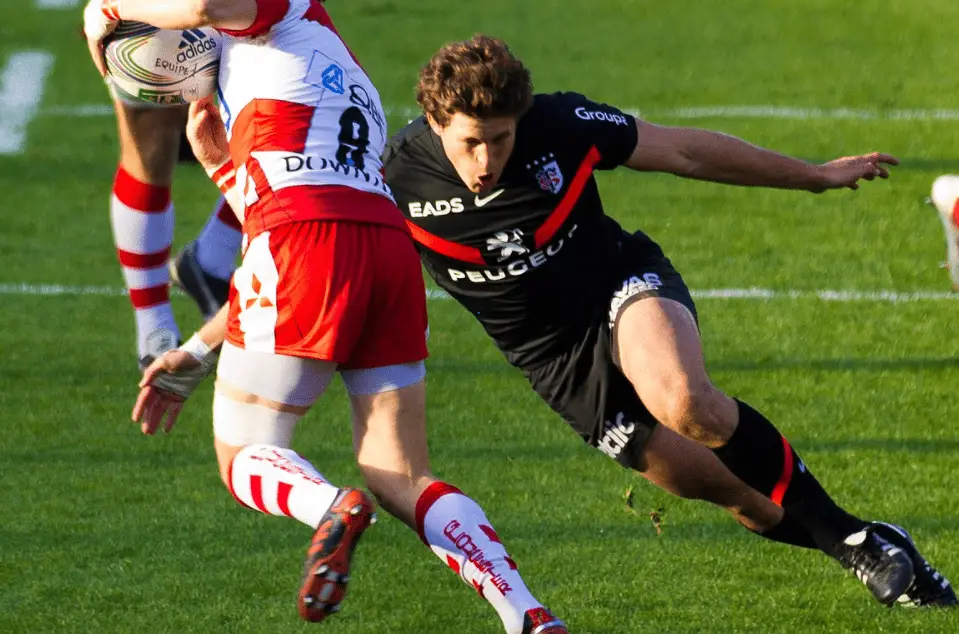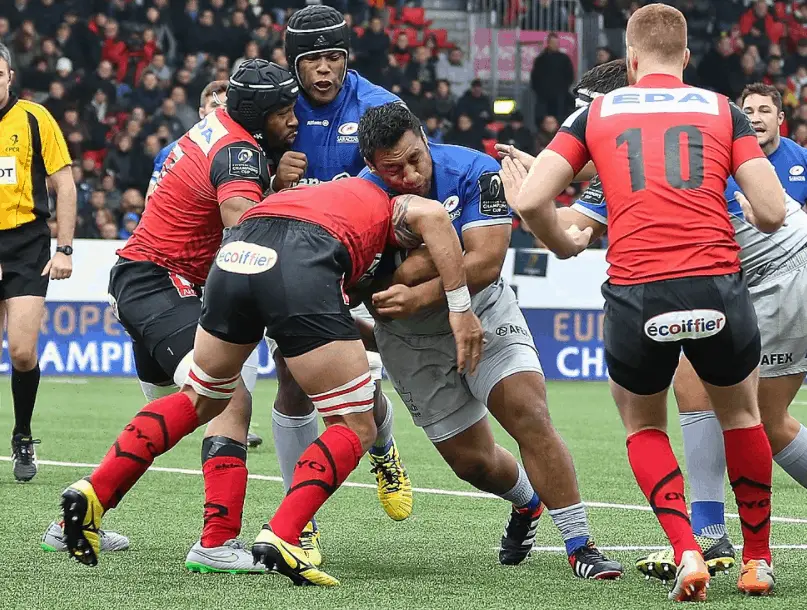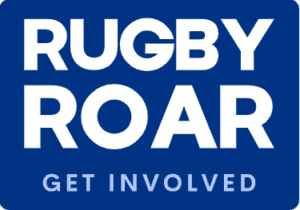Tackling is at the core of the game of rugby and the physical nature of the sport is one of the reasons I love it. However, tackling is not all about aggression, there is a lot of skill involved which revolves around timing and using the technique.
There are 8 different types of tackle that I’m going to talk you through today, each of them you’ll need to master to progress in rugby, they are: the side on tackle, the front on tackle, the tackle from behind, the smoother tackle, the hit and engage, the hit and spin, and the hit and pass. We will also take a look at the crucial skills of how to actually fall to ground correctly.
The Side On Tackle

One of the most common tackles in the game, especially amongst backs who are playing to a drift defense system. As a former outside centre this was a particularly crucial technique for me to master, unfortunately, I did snap both the tendons in my shoulder doing this, but we won the game so it was worth it (incidentally, I played on for the rest of the game too, hard as nails me!). Here’s how to do it:
To tackle side on the tackler targets the hips and upper thighs of the attacker, crouches before contact and then explodes into contact wrapping the arms around the attacker and placing the head cheek to cheek with the opponents behind.
Let’s break that down further:
Before: The tackler should position themselves on the inside shoulder of the ball carrier, or, more often than not this is simply the side of the body presented to the tackler covering across. A few metres before the tackle, crouch down flexing at the knees and the hips. The chin should be kept up, the back should remain straight and the eyes should be fixed on the target.
During: The tackler should explode towards the ball carrier looking to position the head behind the body of the player in what is sometimes known and the cheek to cheek position (bum cheek to face cheek). The shoulder should hit the target area (upper thighs) the arms should wrap the player and the tackler should drive with their legs. Squeezing the legs together and sliding down the legs until the player falls over is the aim.
After: Continue driving the legs if the player does not fall to the ground. If the player goes to ground the tackler most likely will too and it is imperative to roll away from the ball carrier and the ball and get to your feet as quickly as possible. At this point you can then reenter the game from your side of the ruck and compete for the ball.
Pro tip: If the tackle occurs near the touchline it may be possible to use your momentum in the tackle and swing the players legs around to touch the side line and thus put them out of play and gain the turnover.
The Front On Tackle

The most direct and aggressive type of tackle in rugby. A physical contest to stop a players forward momentum and regain possession of the ball. I used to be terrified of doing this and even started closing my eyes at one point! I stopped this as soon as I realised that if I got low enough with a straight back – I was unstoppable! Here’s how to do it:
To perform a front on tackle, immediately before contact, drop your body height by bending at the knees and the hips and lean forward with your head up. Explode into the attacker aiming for contact just under the rib cage and with your head to the side wrap with the arms.
Let’s flesh that our a bit more:
Before: Position yourself slightly inside the ball carrier so you are tickling from out to in. move forward at speed and reduce the attacker’s time to build momentum. A couple of paces before the tackle drop into a crouch position by bending at the knees and the hips but keep the head up.
During: Explode into the attacker aiming for between the waist and the hips making sure the head goes to the near side of the attacker and not across their body. Wrap the arms around the player, you may be able to hook up the nearside leg under the knee joint in order to ensure the lose balance more easily.
After: Land on top of the player and release. Make sure you do not lift the players legs up and tip them over in the process. Try to regain your feet as quickly as possible so that you can contest possession.
Pro tip: At the point of contact the tacklers body should be in contact with the floor from low to high with a straight back. From this position it is very difficult to be knocked backwards. Jonny Wilkinson was the clear master of this and he was not a big guy but could smash players backwards much bigger than himself.
When I met Jonny, I was surprised that he was smaller than me in every way, on television he just looked so dominant in the tackle that I thought he must be bigger (I’m 6 ft and 15st by the way). Interestingly, I collated some information and wrote a detailed article about the average height and weight of professional rugby players that you might be interested in also to see how big these players actually are and where you fit in.
‘You don’t finish the tackle until you are back on your feet.’
Richie McCaw – All Blacks Legend
The Tackle From Behind

A difficult tackle to make as this often has to be done at pace and their is the risk of receiving a back heel. The best players have a knack of getting the timing just right with this. Here’s how to do it:
To tackle from behind, firstly, target the players waist. A dive will be usually be necessary in order to ‘catch up’ with the player. Make contact with the leading shoulder and wrap the arms around the waist, placing your head to the near side of the opponent. Slide down to the legs squeezing them together firmly dropping the player.
Let’s add some meat to the bones now:
Before: Chasing back as quickly as possible, target the lower back with the expectation that as the player is moving away from you, you will naturally hit further down around their waist to complete the tackle.
During: Dive towards the attacker and make contact with the shoulder whilst simultaneously wrapping the arms around the tackler. Slide down to around the players upper thighs and restrict their movement. Squeeze the legs together hard with your upper arms and use the weight of your body to really force them to the ground.
After: Roll away from the tackled player, regain your feet and rejoin play as quickly as possible.
Pro tip: If the player is getting away from you, you can still make an effective tackling by lunging for the back heel and tapping it as hard as possible. More often than not the player will lose their balance and come crashing to the ground.
Jacques Burger Tackling Masterclass
Renowned for his incredible work rate and big hitting tackles, both for Saracens and Namibia, listen to Jacques Burger demonstrate exactly how to make the front on, side on, and tackle from behind.
Jacques Burger Tackling Tips:
Some of Jacques key points for front on tackling and big hitting are as follows:
| – Get off the line hard. – Try and hit man and ball. – Try and get under the ball. – Keep the head up and flat back. – Hit and pick up a leg, or drive through. – Try and picot the player on his center axis point. – Get on your feet and try and get straight on the ball. – If in doubt just take out the legs. |
There are still a few more tackle types to cover so keep on scrolling…
The Tap Tackle

As a bit of a last resort you may be able to bring down an opponent with a tap tackle. It tends to be scrum halves , wingers and full backs covering across that attempt this tackle but anyone could find themselves in the position to execute it. here’s how to tap tackle:
To perform the ankle tap tackle you will be chasing down an opponent and unable to put in a regular tackle. Simply dive with the arm nearest the attacker outstretched, aiming to swipe the standing foot from underneath the runner. Make solid contact on the heel of the boot and try to follow through forcefully.
The Smother Tackle
A great tackle to perform when a larger player is tackling a smaller player, possibly when a forward tackles a back, as obviously greater strength makes it easier to hold the player up and prevent them from offloading. This will lead to a handover of possession in the form of a scrum if the tackled player cannot get the ball away.
Perform the smoother tackle by getting your feet as close to your opponent as possible. Drive into the ball carrier with the shoulder and wrap the arms just above the position of the ball pinning it to their body. Hold the player in this position for as long as possible.
Before: Approach the ball carrier and try to get your feet as close to your opponent as possible thus allowing you to wrap from a closer position and get more purchase with your arms on the ball carrier.
During: Drive into the ball carrier with the shoulder and wrap the arms just above the position of the ball pinning it to their body. Continue driving the player backwards and try and turn them towards your teammates. Try to hold the player up and prevent them from getting the ball away for as long as possible.
After: Continue holding up the player until the referees whistle signals that there will be a handover of possession and a scrum. Teammates will usually arrive to assist and it is important that also get under the ball and help prevent any offloads.
The Hit And Go To Ground
Sometimes the best option to recycle the ball quickly is to just hit the ground, present the ball neatly and allow teammates to move the ball away.
Before: The balls should be held in two hands in order to facilitate an offload if possible or to keep it secure in the contact. On approach to the contact zone the body position should be low and stride lengths should shorten and then there should be one larger power stride into the contact.
During: Here we are looking to drive our legs with continuous short steps for as long as possible. Once this momentum comes to an end it is time to drop to the floor before the opposition have the opportunity to hold you up, it is a fine balance. To do this simply force your upper body to the ground by letting diving forwards and towards the turf.
After: Once on the ground place the ball backwards in two hands if possible towards your teammates coming in to ruck over. You should turn your entire body if possible so that it is parallel to the touchline which will allow you to place the ball as far back on your side as possible.
Pro tip: If you become trapped on the ground after presenting the ball consider placing your hands over your head to avoid catching a stud to the head and opening a cut.
Photo Credits:
Photo 2 – ST vs Gloucester – Luke Burgess tackling 2011, PierreSelim, CC BY-SA 3.0, via Wikimedia Common.
Photo 3 – Maro Itoje and Mako Vunipola facing Olivier Missoup, Leon Power and Rory Clegg 2015 Clément Bucco-Lechat, CC BY-SA 3.0, via Wikimedia Commons
Photo 4 – Guy M’ (11) playing against Spratton Prep’ School in a Rugby Union match 11/2005; picture by R Neil Marshman (c) No machine-readable author provided. Brookie assumed (based on copyright claims)., CC BY-SA 3.0, via Wikimedia Commons
Photo 5 – Saracens – 20151213 – Richard Wigglesworth, Guillaume Boussès and Chris Ashton Clément Bucco-Lechat, CC BY-SA 3.0, via Wikimedia Commons

